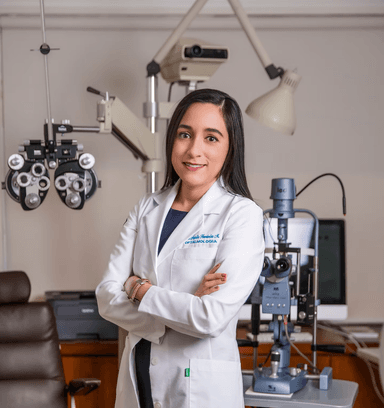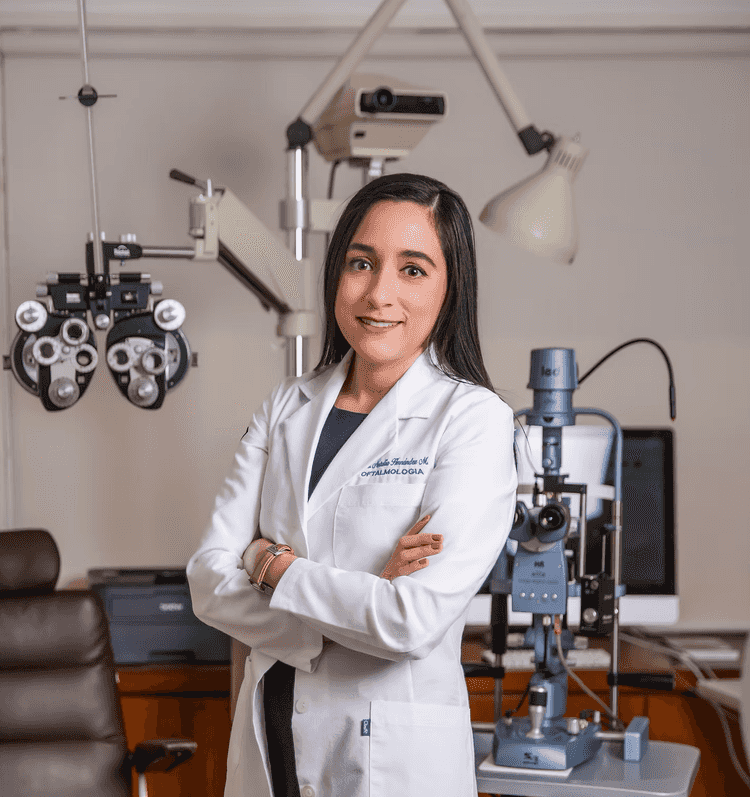How To Get Rid of Cataracts Without Surgery: Understanding Your Options

Prathyusha Itikarlapalli
- Content Writer

Dr. Natalia Hernandez Martinez
- Reviewed by

Key Takeaways
- The World Health Organization (WHO) states that cataracts are a leading cause of blindness worldwide. They begin as a thickened lens that gradually turns opaque. Patients experience blurry vision that progresses to complete blindness over several months or years.
- While many wonder how to get rid of cataract without operation? There is no currently approved non-surgical method for treating cataracts. Eyedrops to dissolve cataracts, based on oxysterol and N-acetylcysteine amide (NACA), are still under research.
- Cataract surgery remains a safe, effective, and approved treatment method. The surgery time is approximately 15-20 minutes, with a brief recovery period.
Cataracts Are a Leading Cause of Blindness
A cataract forms within the eye when the natural lens thickens and becomes clouded. Patients initially experience blurry vision in the affected eye, which gradually worsens over time. When left untreated, cataracts can even lead to blindness. Cataracts are a global problem and the second leading cause of blindness. Over 100 million people worldwide suffer from cataracts, with 17 million of them ending up going blind. Nearly 70 million people suffer from vision problems caused by cataracts, with varying degrees of severity.[1]
It's worth mentioning that not all cataracts cause blindness. Their impact on vision depends on the degree of the cataract, the underlying eye condition, and the individual's age. Cataracts occur when the proteins within the natural lens of the eye break down and accumulate, forming a thick, dense mass. This occurs as part of natural aging or due to factors such as UV exposure, smoking, or other health issues. While the causes may differ, the effect of protein breakdown remains the same. The thickened eye lens cannot focus the light onto the retina, like a transparent healthy eye lens does. Cataract formation is a gradual process, but its effects can be severe. Having known the seriousness of cataracts, you may wonder about better ways to treat them. Head to the upcoming section for details.
How To Remove Cataracts: A Brief on the Current Treatments
The only treatment method with proven results to treat cataracts is their surgical removal. The ophthalmologist surgically removes the clouded eye lens and places a clear synthetic intraocular lens (IOL). Surgery may seem overwhelming to many. So if you ask us, “Can cataract be cured by laser?” the answer is Yes!
Laser cataract eye surgery is an alternative to traditional surgery. It offers a more advanced and precise approach to treating cataracts. Ophthalmologists use surgical lasers to make incisions, break down the thickened lens, and then extract and place the intraocular lens (IOL). Using lasers ensures precision and quick recovery. That too with a short surgery time! You will see the results clearly within one to two days.

However, the problem lies in training your eyes after cataract eye surgery. While cataracts develop gradually, your brain learns to process the hazy images. And now, after the surgical removal of cataracts, it's your turn to train your brain to process clear and sharp images. So, it takes some time to adjust after cataract surgery. Furthermore, patients still see cataract removal as a surgery, which may seem overwhelming. Despite its quick recovery time and low risk, the idea of eye surgery can still feel intimidating. And if you ask us, Is it possible to get rid of cataracts without surgery? We invite you to proceed to the next section.
Can a Cataract Be Removed Without Surgery?
Currently, there aren’t any available or approved non-surgical treatment approaches for cataract removal. Many people wish there were a pill instead of surgery, but right now, surgery is the only treatment that works. Researchers are still studying other options.
Studies on How To Reduce Cataract Without Surgery
Here is a brief overview of the research being conducted worldwide to develop eye drops that dissolve cataracts.
A 2015 study revealed that compounds like lanosterol can delay and reverse protein aggregation within the eye lens.[2] While there are a few limitations with the ability of lanosterol, the focus shifted to more efficacious strategies. In 2017, studies were conducted on animals using antioxidant-based cataract reversal. While cataract formation is multifactorial, researchers focused on oxidative stress as a significant contributing factor in these studies. They used N-acetylcysteine amide (NACA) eyedrops to study their efficiency in dissolving cataracts in laboratory mice.[3] A few other studies have aimed to dissolve proteins involved in cataract formation due to aging. They used oxysterol for this purpose, which showed a 61% improvement in the laboratory animals.[4] However, it's worth mentioning that these research studies are still in very early stages. More research is necessary before these animal studies can be applied to human cataracts.
So, if you are wondering, “Is there a way to fix cataracts without surgery?” The straight answer is that you still need to wait for the latest cataract treatment without surgery. An effective, safe, and approved non-surgical option is still in the laboratory stage, and it may take years of research, followed by clinical trials, before it becomes available for human use. Until then, surgical cataract removal remains the safest and most effective option. But if you ask us, does every candidate suffering from cataracts require surgery? We invite you to proceed to the upcoming section.
How Long Can You Live With Cataracts Without Surgery?
Ophthalmologists generally recommend cataract surgery only when the opaque lens interferes with daily activities. This timeframe can range from several months to a few years, depending on the specific case. Typically, it depends on the rate of cataract progression, the patient's age, and their overall health and eye conditions.
Note that cataract formation is a gradual process. Surgical removal is not for the early stages of cataracts. So, being diagnosed with cataracts does not mean you should rush for surgery. Ophthalmologists recommend new prescription glasses or contact lenses during the early days after you notice cataract formation. Additionally, you will attend routine eye examinations to monitor the progression of cataracts. Adopting minor measures, such as wearing anti-glare glasses and using brighter lights, can help alleviate the initial symptoms.[5] This will help you see better, as early cataracts simply cause hazy eyesight. However, in a few cases, cataract surgery should not be delayed. This applies to:
- Candidates who rely heavily on clear vision, such as pilots and drivers, whose job requirements mandate sharp eyesight.
- Aged seniors are at risk of falls, as poor eyesight increases the risk of accidents and injuries.
- People suffering from bilateral cataracts (affecting both eyes simultaneously) often experience difficulties with balance and depth perception.
- Patients with other eye problems like glaucoma, diabetic retinopathy, and macular degeneration, since cataracts can only deteriorate their eye health further.
- Children in their growing years have rapidly developing brains. Delaying cataract surgery may have a permanent impact.
What Happens if You Don’t Have Cataracts Removed?
Leaving cataracts untreated can ultimately lead to vision loss. Cataracts develop gradually, and their effects typically begin with blurry vision. The damaged proteins accumulate within the natural lens, blocking the passage of natural light. And eventually, patients face complete vision loss when the eye lens loses its transparency and turns completely opaque. In fact, the World Health Organization (WHO) states that cataracts are a leading cause of vision loss worldwide.[6] Having known the real facts, it's time to bust a few myths surrounding home remedies and natural cures for cataracts.
How Can I Shrink My Cataracts Naturally?
Some cultures recommend natural remedies for cataracts, utilizing herbal medicine. Plant extracts, such as Bilberry, Eyebright, and castor oil drops, are often praised as natural remedies. A few may consider them a myth. However, patients should look for more research-backed products when seeking natural alternatives to cataract surgery.
Natural compounds with antioxidant and anti-inflammatory properties, particularly in certain plant extracts, are often studied for their potential to shrink and reverse cataracts. [7] Additionally, plant extracts and natural compounds, such as curcumin, vitamin C, and E, are being studied for their anti-cataract and antioxidant properties.[8] However, most of the research studies focus on the ability of the compounds. Their efficacy and standard protocols require further study.
More importantly, the cataract formation follows a multifactorial process. The causes can include mutations, oxidative stress, crystallin problems, and protein structure abnormalities. While this varies with the patient, addressing the root causes of cataract without surgery remains highly challenging. Current natural or pharmaceutical interventions may support eye health, but none have been proven to reverse cataracts in humans fully.
Can You Prevent Cataract Formation?
While you cannot prevent cataracts formed due to genetics or aging, you can definitely slow down their progression or reduce your risk. This can be achieved by prioritizing eye health through lifestyle changes and eye-protective measures.
- Wear sunglasses when outdoors and protect your eyes from harmful UV rays.
- Manage chronic health and eye problems like diabetes, glaucoma, and uveitis.
- Limit alcohol consumption and smoking to reduce the negative impact of oxygen-free radicals.
- Rely on a health diet rich in vitamins A and E, which improves your overall eye health while reducing the risk of cataracts.
- Attend routine eye checkups to keep your eye health monitored. It will help in the early identification of risks.
Final Word!
Many wonder how to get rid of cataracts without surgery, but current science still points to surgery as the only proven treatment. While research continues, protecting your eye health through lifestyle changes is your best bet for now.
Don’t let cataracts cloud your life. We connect you with top-rated surgeons and internationally accredited clinics that deliver results safely and affordably. Sign up with Envoy Health today and see the difference for yourself.
References
- Prevalence Of Cataract And Its Associated Factors Among Adults Aged 40 Years And Above Living In Durame Town, Southern Ethiopia, 2023: A Community-Based Cross-Sectional Study
- Dissolving Cataracts With Eye Drops Instead Of Surgery?
- Prevention And Reversal Of Selenite-Induced Cataracts By N-Acetylcysteine Amide In Wistar Rats
- Oxysterol Compounds In Mouse Mutant Αa- And Αb-Crystallin Lenses Can Improve The Optical Properties Of The Lens
- At A Glance: Cataracts
- Blindness And Vision Impairment
- Medicinal Plants And Natural Products Used In Cataract Management
- Antioxidants And Cataract
Disclaimer
The information in this article is for educational purposes only and does not replace medical advice. Always consult your doctor before starting any treatments.
Laser cataract treatment without surgery is the fastest way to eliminate cataracts. The procedure takes 15-20 minutes and has a relatively shorter recovery time. You will see clearly within 48 hours of laser cataract surgery.
Cataracts cannot clear up on their own. The protein within the lens breaks down and accumulates, resulting in a permanent change. Cataract reversal cannot happen on its own. Ophthalmologists remove the damaged eye lens and replace it with a synthetic lens, allowing you to see clearly.
Cataract removal without surgery is currently at the laboratory stage. The approved methods of application are conventional cataract surgery and laser cataract surgery. Research studies aimed at dissolving cataracts or slowing their progression are underway. Antioxidant compounds, such as N-acetylcysteine amide (NACA) and oxysterol, were found to be effective in dissolving cataracts. However, they are still not approved for human usage.
Cataracts cannot be cured with eye drops. The surgical removal of cataracts is the only approved method to date. Research aimed at dissolving cataracts without surgery is still underway. It needs to undergo laboratory studies, followed by clinical studies, before being used in humans.
Removing cataracts without surgery is not possible. Ophthalmologists remove the damaged eye lens and place an IOL in its place, allowing you to see clearly. While surgery remains the only approved method, you can prioritize eye health by maintaining a diet ample in vitamins A and E, as well as by protecting your eyes from harmful UV rays. This will slow down the progression of cataracts and prevent other eye problems, thereby protecting your eye health.
One can live with cataracts until they cause major changes in vision. Cataracts do not interfere with daily life tasks during their initial stages. So, you need not rush for surgery as soon as you are diagnosed with cataracts. However, surgery can be your sole treatment choice when the cataracts cause complete vision problems.
So, we partner with the premier healthcare facilities!
Send me the list
